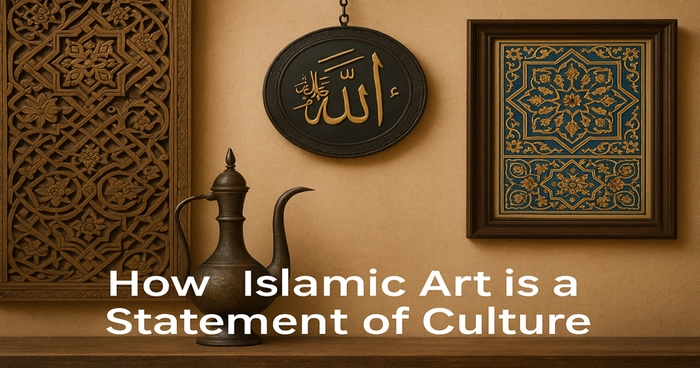How Islamic Art is a Statement of Culture
My grandmother's hands traced the intricate patterns on our living room wall, her eyes twinkling with memories of her childhood home in Damascus. The wall before us contained universes within its geometric patterns - each star, each line, each curve flowing into infinity. That moment began my lifelong journey into understanding Islamic Art.
The Origins
Growing up surrounded by Islamic Art and Culture, I discovered a heritage born from the golden age of Islamic civilization. The story begins in the 7th century when the expanding Islamic empire encountered the artistic traditions of the Byzantine, Persian, and Central Asian worlds. Trade routes stretching from Spain to China created a melting pot of artistic techniques and motifs.
The Byzantine Empire contributed its mastery of mosaics and architectural grandeur. Persian artisans brought their sophisticated traditions of manuscript illustration and metalwork. From Central Asia came intricate textile patterns and innovative ceramic techniques. Early Muslim artisans transformed these influences through the lens of Islamic principles, particularly tawhid (divine unity) and aniconism (avoiding representation of living beings).
This transformation gave birth to distinctive Islamic Artworks characterized by:
-
Arabesque patterns that flow endlessly, symbolizing divine infinity
-
Geometric designs based on precise mathematical principles
-
Stylized plant motifs that celebrate the beauty of God's creation
-
Masterful calligraphy that elevated Arabic script to high art
The Sacred Geometry
The geometric patterns in Islamic Art Culture opened my eyes to mathematics in art. During my first visit to the Alhambra in Spain, I watched sunlight dance across walls covered in Islamic Mosaics. The intricate star patterns expanded from simple shapes into complex designs, embodying the mathematical precision of Islamic Aesthetics. These patterns taught me about the concept of infinite repetition - a visual representation of divine endlessness.
Words as Art
"The pen writes what the heart speaks," my calligraphy teacher would say as he demonstrated the fluid motions of Arabic script. Islamic Ornamentation transformed writing into visual poetry. In manuscripts centuries old, I saw how artists elevated every letter into a masterpiece. The marriage of script and decoration in Islamic Art and Culture created pages that sang with both meaning and beauty.
Building Beauty
Standing beneath the soaring domes of Istanbul's Blue Mosque reveals how Islamic Art revolutionized architecture. Master builders developed innovative techniques to create increasingly larger domes, using muqarnas (honeycomb vaulting) to transition between square and circular spaces. These architectural innovations spread across continents, influencing building styles from Spain to India.
The walls of these magnificent structures showcase the full spectrum of Islamic artistic expression:
-
Islamic Tapestries woven with metallic threads capture and reflect light
-
Islamic Carvings in stone and wood create layers of shadow and texture
-
Ceramic tiles arranged in complex geometric patterns cover vast surfaces
-
Calligraphic friezes wrap around domes and minarets, binding architecture with sacred text
Water features play a crucial role, with reflecting pools multiplying the visual impact of architectural elements while creating a multisensory experience. Gardens follow geometric layouts that mirror the patterns found in Islamic Mosaics, creating paradise-like spaces that engage all senses.
Modern Voices
Contemporary Islamic Painters and artists are revolutionizing traditional forms while honoring their core principles. The Hurufiyya movement, emerging in the mid-20th century, liberated Arabic script from classical rules, transforming letters into dynamic abstract forms. Artists like Shakir Hassan Al Said and Madiha Omar pioneered new approaches to Culture Artwork, using calligraphy as a means of modern expression.
Today's innovation takes many forms:
-
Digital artists create parametric designs based on traditional geometric principles
-
Installation artists transform classical patterns into immersive environments
-
Contemporary Islamic Mural artists blend traditional motifs with street art aesthetics
-
Multimedia artists incorporate Arabic script into video and light installations
Modern materials and technologies have opened new possibilities:
-
Laser-cutting enables intricate geometric patterns in metal and acrylic
-
3D printing allows complex muqarnas forms in contemporary architecture
-
Digital projection mapping brings static patterns to dynamic life
-
Smart materials create interactive installations based on traditional designs
The heart of innovation lies in how artists address contemporary issues through traditional visual language. Environmental concerns, social justice, and cultural identity find expression through geometric patterns and calligraphic forms. This fusion of ancient wisdom with modern concerns ensures that Islamic Art Culture remains relevant and vital in the 21st century.
Art Without Borders
Last month, I visited an exhibition of The Islamic Art that drew people from all walks of life. Children sketched patterns in notebooks while elderly visitors shared stories about similar designs in their family homes. This universal appeal of Culture in Art reminded me of my grandmother's words about patterns speaking a language everyone understands.
Living Heritage
Today, when I look at my own collection of Islamic Artworks, each piece tells multiple stories. They speak of mathematical precision and spiritual devotion, of cultural identity and artistic innovation. This artistic tradition connects us to centuries of human creativity while remaining vibrantly alive in the present.
The geometric stars that once fascinated me in my grandmother's home now adorn my own walls, teaching my children about their heritage. Through these patterns, they learn that Islamic Art belongs both to history and to the future. Every piece carries forward a legacy of beauty, precision, and cultural pride that continues to inspire new generations of artists and admirers alike.
In my travels across continents, I've seen how these artistic traditions adapt and thrive in different contexts. From the traditional workshops of Fez to contemporary galleries in Dubai, artists maintain core principles while exploring new possibilities. This living tradition proves that great art transcends time and borders, creating connections that enrich our shared human experience.

